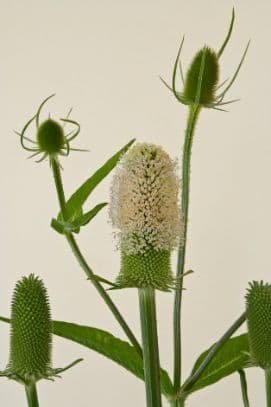Weigela Weigela 'Féerie'

ABOUT
Weigela 'Féerie' is a deciduous shrub that showcases a dense, rounded form. Its branches arch gracefully and are lined with oval-shaped leaves that exhibit a lustrous deep green color. This foliage backdrop becomes a magnificent setting for the floriferous display in late spring to early summer when this shrub bursts into color with trumpet-shaped flowers. The blooms, often pink or a magenta hue, are profuse and clustered along the branches, creating a striking contrast against the greenery. The flowers are known to attract hummingbirds and other pollinators, adding movement and life to the garden scene. With each individual flower composed of a flared tube and a five-lobed opening, Weigela 'Féerie' exudes a romantic and old-fashioned charm that can enliven any garden space.
About this plant
 Names
NamesFamily
Caprifoliaceae
Synonyms
Weigela, Old Fashioned Weigela
Common names
Weigela 'Féerie'.
 Toxicity
ToxicityTo humans
Weigela 'Féerie', commonly referred to as Weigela, is not widely recognized for its toxicity to humans. Generally, it is considered non-toxic, and there is no well-documented evidence to conclude that ingesting parts of this plant causes poisoning in humans. However, as with any plant, individual sensitivities can vary, and it is still advisable to prevent children from ingesting plant material to avoid potential digestive upset or allergic reactions.
To pets
Weigela 'Féerie', commonly known as Weigela, is not known to be toxic to pets. It is not listed on common toxic plant databases for pets such as dogs and cats, and ingestion is unlikely to cause poisoning. However, while it is not considered highly toxic, ingestion of any non-food plant material can sometimes lead to gastrointestinal upset in pets, so monitoring is recommended if a pet consumes this plant.
 Characteristics
CharacteristicsLife cycle
Perennials
Foliage type
Deciduous
Color of leaves
Green
Flower color
Pink
Height
6 feet (1.8 meters)
Spread
5 feet (1.5 meters)
Plant type
Shrub
Hardiness zones
4
Native area
Asia
Benefits
 General Benefits
General Benefits- Attractive Flowering: Weigela 'Féerie' features abundant pink to red trumpet-shaped flowers in late spring that attract pollinators and provide visual interest.
- Low Maintenance: It is a hardy shrub that requires minimal care once established, which can be ideal for busy gardeners or those with limited horticultural skills.
- Decorative Foliage: The plant showcases attractive green foliage that adds a lush backdrop to garden settings throughout the growing season.
- Wildlife Habitat: The flowers of Weigela 'Féerie' attract hummingbirds and butterflies, providing a habitat for these beneficial creatures.
- Versatility in Landscape Design: This shrub can be used in a variety of settings, including borders, hedges, and as a stand-alone specimen.
- Seasonal Interest: Besides its spring blooms, some varieties offer autumn foliage color, adding seasonal interest to the garden.
- Drought Tolerance: Once established, Weigela 'Féerie' can tolerate periods of low water, making it suitable for xeriscaping or areas with water restrictions.
 Medical Properties
Medical PropertiesThis plant is not used for medical purposes.
 Air-purifying Qualities
Air-purifying QualitiesThis plant is not specifically known for air purifying qualities.
 Other Uses
Other Uses- Weigela 'Féerie' can be used in bonsai culture for those who enjoy the art of creating miniature landscapes, offering vibrant blooms and a unique shape with proper pruning.
- The flowers of Weigela 'Féerie' can be used in floral arrangements and bouquets as they add a burst of color and distinctive form to any floral design.
- With its dense foliage and growth habit, Weigela 'Féerie' can offer privacy screening in gardens or patios, blocking the view from nosy neighbors or passersby.
- As a natural food source, the nectar-rich flowers attract pollinators such as bees and butterflies, making Weigela 'Féerie' ideal for wildlife gardens and conservation efforts.
- Its woody branches can be used in crafting and decorative woodwork, giving DIY enthusiasts a source of raw material for their projects.
- Weigela 'Féerie' can serve as a natural noise barrier when planted densely, helping to reduce traffic sounds and create a peaceful backyard environment.
- Weigela 'Féerie' can be integrated into thematic garden designs like cottage gardens or fairy gardens, contributing to the narrative with its enchanting blooms.
- The shrub can be used for creating a 'living' play area for children, with its safe, soft branches and appealing flowers that can inspire imagination and play.
- For those interested in wildlife photography or insect observation, planting Weigela 'Féerie' offers numerous opportunities to capture images of visiting pollinators and garden fauna.
- As an education tool, Weigela 'Féerie' can be used to teach children or gardening novices about plant growth cycles, pollination, and pruning techniques.
Interesting Facts
 Feng Shui
Feng ShuiThe Weigela is not used in Feng Shui practice.
 Zodiac Sign Compitability
Zodiac Sign CompitabilityThe Weigela is not used in astrology practice.
 Plant Symbolism
Plant Symbolism- Beauty: With its funnel-shaped flowers and elegant structure, Weigela is often associated with beauty and grace in the garden.
- Nostalgia: Weigela plants are often found in older, established gardens. They can evoke a sense of nostalgia and a connection to the past.
- Prosperity: The abundance of flowers produced by the Weigela, especially the 'Féerie' variety, can symbolize prosperity and abundance.
- Endurance: Weigela is a hardy plant that can withstand various conditions, symbolizing endurance and adaptability.
 Water
WaterWeigela 'Féerie', commonly known as just Weigela, should be watered thoroughly to establish deep root systems, especially during its first growing season. Once established, it requires less frequent watering but make sure to keep the soil consistently moist, particularly in dry conditions. Generally, Weigelas may need watering once a week with about 1 to 1.5 gallons of water each time, depending on soil type, weather, and plant size. During peak summer heat, monitoring the soil moisture is crucial; if the top inch of soil is dry, it's time to water. Over-watering can lead to root rot, so ensure good drainage and avoid letting the plant sit in soggy soil.
 Light
LightWeigela 'Féerie' thrives best in full sun to partial shade. For optimal blooming, plant it in a spot that receives at least 6 hours of direct sunlight each day. Some afternoon shade can be beneficial in extremely hot climates, but too much shade can reduce flowering and lead to leggy growth.
 Temperature
TemperatureWeigela prefers a temperate climate and is hardy in USDA zones 4 through 8. It can typically handle temperatures as low as -30°F and as high as 90°F, however, its ideal growing temperatures are between 55°F and 75°F. Sudden temperature fluctuations and extreme cold or heat can stress the plant, so planting it in a location sheltered from harsh winter winds and extreme summer heat is beneficial.
 Pruning
PruningPruning Weigela is important to maintain its shape and invigorate new flowering growth. The best time to prune is immediately after the spring flowering period to shape the plant and remove any dead or crossed branches. Weigela blooms on old wood, so annual pruning is recommended; however, drastic pruning should be done less frequently, perhaps every few years, to rejuvenate older plants.
 Cleaning
CleaningAs needed
 Soil
SoilWeigela, including the 'Féerie' variety, prefers well-draining soil that is rich in organic matter. A mix of garden soil, peat moss, and perlite or coarse sand can create a suitable environment for healthy growth. The ideal soil pH for Weigela 'Féerie' should be slightly acidic to neutral, ranging from 5.5 to 7.5.
 Repotting
RepottingWeigela 'Féerie' is typically grown outdoors and does not require frequent repotting. If grown in a container, it should be repotted when the roots fill the pot, roughly every 2-3 years.
 Humidity & Misting
Humidity & MistingWeigela 'Féerie' does well in average outdoor humidity levels and does not require specific humidity conditions. It is adaptable to the typical range of outdoor humid environments.
 Suitable locations
Suitable locationsIndoor
Provide bright light and prune to shape Weigela 'Féerie' indoors.
Outdoor
Plant in sun, well-draining soil, water regularly for Weigela 'Féerie'.
Hardiness zone
4-8 USDA
 Life cycle
Life cycleThe Weigela 'Féerie', also known as Weigela floribunda, begins its life as a seed that germinates in spring under the right conditions of moisture and temperature. The seedling emerges and grows into a young plant, developing a root system and foliage over the first growing season. As it matures, Weigela 'Féerie' enters a vegetative stage, where it focuses on leaf and stem growth, establishing a robust framework for future flowering. Once mature, the plant enters the flowering stage, typically in late spring to early summer, showcasing trumpet-shaped, pink to red blossoms that attract pollinators such as bees and butterflies. After pollination, the flowers develop into small capsules containing seeds, which, when mature, are dispersed by wind or animals to start a new generation. The plant then goes into a period of dormancy during the colder months, storing energy in its roots to survive the winter and resume growth in the following spring.
 Propogation
PropogationPropogation time
Spring-Early Summer
The most popular method to propagate Weigela 'Féerie', commonly known as Weigela, is via softwood cuttings in late spring or early summer as the plants are actively growing. Choose a healthy, non-flowering stem and make a cut about 4-6 inches (10-15 centimeters) long just below a leaf node. Remove the leaves from the lower half of the cutting and dip the cut end into a rooting hormone to encourage root growth. Insert the cutting into a pot filled with a well-draining soil mix, leaving several leaf nodes above the surface. Keep the soil moist but not waterlogged, and place the pot in a warm spot with indirect sunlight. Roots typically develop within a few weeks, after which the cutting can gradually acclimatize to normal outdoor conditions before being planted in its permanent location.








